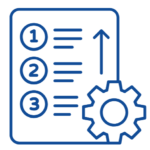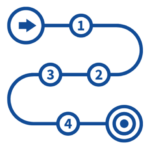The interagency Great Lakes Restoration Initiative (GLRI) targets improvements to address the most significant environmental problems within the Great Lakes Basin. Through an agreement with the Environmental Protection Agency (EPA), the U.S. Department of Agriculture (USDA), Forest Service anticipates receiving funds to support competitive projects that implement strategic, priority actions within Forest Service authorities to restore, protect, and maintain the Great Lakes ecosystem. Awarding of grants is contingent on allocation of EPA funding.
Successful projects will implement reforestation and other forest restoration activities to address invasive species, nonpoint source pollution impacts on nearshore health, and habitat restoration in coastal and riparian areas, while paying attention to measurable on-the-ground impacts, connections between terrestrial forested landscapes and water quality, resilience to climate change and other ecosystem stressors, and environmental justice.
Click through the sections below to learn more about this funding opportunity.
 Grant priorities include:
Grant priorities include:
Projects in this category will implement targeted reforestation and forest protection actions to minimize invasive forest insect and disease impacts on watersheds. Successful applications will demonstrate how targeted restoration or protection of canopy cover benefits water quality, watershed processes, and/or priority habitats.
Projects receiving additional emphasis include those that minimize non-native invasive insect and disease impacts where tree damage and mortality pose a particularly high risk to hydrologic function and ecosystem integrity in a watershed or that increase environmental justice through integrated programs for non-native invasive insect and disease resilience, equitable environmental benefits, and improved quality of life for adjacent or downstream communities.
Projects in this category will capture or treat stormwater runoff by planting trees and other vegetation as an integral component of green infrastructure. Under this program area, tree planting should be the main green infrastructure strategy used for a stormwater mitigation project. Examples of green infrastructure may include:
Projects receiving additional emphasis include those that increase capacity, expertise, and engagement in maintaining community trees, particularly in underserved communities.
Projects in this category will protect, restore, and connect high-quality coastal and connecting ecosystems where trees are an important component. Examples of included habitats are coastal wetlands, drowned river mouths, dune and swale habitats, forested coastal buffers, and critical connecting riparian areas. Applications should highlight any geographical, hydrological, biological, or habitat-related connections of project areas to coastal wetlands. Projects focused only on non-native invasive species management as a restoration method and outcome will not be given priority for this program area.
Projects receiving additional emphasis include projects that address climate change impacts and account for future conditions under a changing climate (e.g., using climate-adapted species, identify sites that provide key habitat to mitigate climate change effects, etc.) or that address environmental justice through equitable access to natural areas, cultural resources, environmental benefits, and/or improved quality of life for adjacent or downstream communities.
Click on the next section to learn more about this funding opportunity’s eligibility requirements.
 Requirements for this funding opportunity include:
Requirements for this funding opportunity include:
To be successful, applications must conform to the authorities of the Cooperative Forestry Assistance Act of 1978 (as amended), specifically Sections 3. Rural Forestry Assistance; Section 5. Forest Stewardship; Section 8. Forest Health Protection; and Section 9. Urban and Community Forestry Assistance.
For a full list of minimum requirements, please refer to page 7 of the Request for Applications.
Click on the next section to learn more about the matching requirements for this funding opportunity.
 Matching funds are not required for this program.
Matching funds are not required for this program.
Click on the next section to learn more about the eligible costs for this funding opportunity.
 Eligible costs include:
Eligible costs include:
Ineligible costs include:
For more complete information, please refer to page 3 of the Request for Applications.
Click on the next section to learn more about this funding opportunity’s project timeline.
 Projects must be completed within two years of the award date. It may take up to six months from project selection for award recipients to receive funds.
Projects must be completed within two years of the award date. It may take up to six months from project selection for award recipients to receive funds.
Click on the next section for this funding opportunity’s application deadline and forms.
 Applications must be submitted by 6:00 p.m. ET on September 18, 2024.
Applications must be submitted by 6:00 p.m. ET on September 18, 2024.
Prior to submitting an application, applications are encouraged to consult with their appropriate state forester, tribal administrator, or forest supervisor to develop and submit the application. Applications must be submitted online through Grants.gov (Grant Opportunity Number USDA-FS-GLRI-FR24). Applicants must obtain a UEI number and SAM registration status.
Click on the next section to access the Contact Information for this funding opportunity.
 For the primary contact for this grant, please contact:
For the primary contact for this grant, please contact:
Erin Barton, Eastern Region GLRI Coordinator
Phone: (612) 476-5849
For the general program staff, please email:
General Program Staff
For the IL, IN, MI, MN, and WI Field Office Staff, please contact:
Gina Jorgensen, St. Paul Field Office Representative
Phone: (651) 649-5276
For the Program Area 1 Midwest States Staff, please contact:
James Jacobs, USDA Forest Service
Phone: (651) 649-5266
For Grants.gov assistance, please contact:
Customer Support
Phone: (800) 518-4726

A WaterNow Alliance Initiative
Whether you have a project that needs support or are just dipping your toe in, our team of experts is here to help.